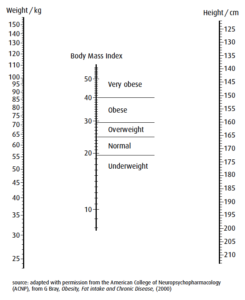IB Biology SL Paper 2 Question Bank
Looking for a way to ace your IB Biology SL Paper 2 exam? Well, look no further than our IB Biology SL Paper 2 Question Bank! This comprehensive question bank covers all the key topics you’ll need to know for your exam, and provides detailed explanations for each answer. With various questions to practice, you’re sure to be well-prepared for the exam day.
Biology Standard Level Paper 2
Time: 1 hour and 15 minutes
Instructions to candidates
- Do not open this examination paper until instructed to do so
- Section A: answer all questions
- Section B: answer one question
- Answers must be written within the answer boxes provided.
- A calculator is required for this paper.
- The maximum mark for this examination paper is [50 marks].
SECTION: A
1.) The body mass index (BMI) takes into account the weight and height of a person and can be used to determine if a person is overweight or obese. The nomogram shows the body mass index for a range of weights and heights.

A. State the weight description of a 75 kg man who is 145 cm tall.
Obese
B. A woman of height 150 cm has a BMI of 40. Calculate the minimum weight she must lose to be
considered ‘normal’.
35kg (±2)
C. Outline the relationship between height and BMI for a fixed weight.
As height increases, body mass index decreases or vice versa.
2.) Blind mole rats (Spalax ehrenberghi) are adapted to live in underground burrows with very low oxygen conditions. Scientists compared blind mole rats and white rats in order to determine whether these adaptations are due to changes in their ventilation system. Both types of rats were placed on a treadmill and the amount of oxygen consumed was measured at different speeds. This study was done under normal oxygen conditions and under low oxygen conditions.
The results are shown in the scatter graphs below.

A. Compare the oxygen consumption of blind mole rats and white rats when the treadmill is not moving.
Blind mole rats have a lower oxygen consumption than white rats
B. Compare the effect of increasing the treadmill speed on the oxygen consumption in both types of rats
Both graphs show greater speed correlated to greater consumption; positively correlated. Blind mole rats consume less oxygen at lower speeds than white rats. But white rats consume less oxygen at higher speeds
C. Evaluate the effect of reducing the amount of oxygen available on both types of rats.
There is a lower oxygen consumption in both types of rats. There is a smaller effect on blind mole rats than on white rats. A plateau is reached in white rats at a lower speed.
3.) A new factory has recently been built near a river that is home to a variety of aquatic species, including fish, frogs, and insects. The factory has been discharging waste products into the river, causing a decline in water quality and an increase in pollution levels. As a result, the local ecosystem is under threat, and some species are starting to disappear.
A) Using the data provided, describe the changes in water quality and pollution levels in the river over the past year.
The data shows that the levels of dissolved oxygen, pH, and nitrate levels have decreased, while the levels of ammonia and phosphate have increased, indicating a decline in water quality and an increase in pollution levels.
B) Explain the potential impacts of pollution on aquatic ecosystems, and identify the specific species that are most vulnerable to pollution.
Pollution can have a range of impacts on aquatic ecosystems, including reduced dissolved oxygen levels, increased acidity, and toxicity to organisms. Species that are most vulnerable to pollution include those that require high levels of dissolved oxygen, such as fish and aquatic invertebrates.
C) Using the data provided, analyze the changes in the populations of fish, frogs, and insects in the river over the past year.
The data shows that the populations of fish and frogs have decreased significantly, while the population of insects has increased. This suggests that the pollution has had a greater impact on the higher trophic levels of the food chain.
D) Propose a plan to reduce pollution levels in the river and protect the local ecosystem. Evaluate the potential effectiveness of your plan.
One possible plan to reduce pollution levels in the river is to require the factory to implement a wastewater treatment system that removes pollutants before they are discharged into the river. This could include physical, chemical, and biological treatment processes. The effectiveness of the plan would depend on factors such as the design and operation of the treatment system, as well as the level of compliance and enforcement.
E) Discuss the ethical implications of pollution and the responsibility of industries to protect the environment.
The ethical implications of pollution include the impact on human health, the welfare of animals, and the sustainability of ecosystems. Industries have a responsibility to minimize their impact on the environment and to prioritize the protection of public health and the environment. This can be achieved through a combination of regulatory frameworks, voluntary actions, and public pressure.
4.) Amylase is an enzyme that breaks down starch into glucose. A student conducted an experiment to investigate the effect of temperature on the activity of amylase. The student added amylase to a starch solution and measured the amount of glucose produced at different temperatures. The results are shown in the graph below.
A) Identify the independent and dependent variables in this experiment.
The independent variable is temperature, and the dependent variable is the concentration of glucose produced by amylase.
B) Describe the relationship between temperature and enzyme activity based on the data in the graph.
The graph shows that enzyme activity increases with temperature up to a certain point (around 37-40°C), after which it rapidly declines. This suggests that there is an optimal temperature range for amylase activity.
C) Explain why the rate of enzyme activity decreases at temperatures above 40°C.
At temperatures above 40°C, the enzyme begins to denature, meaning that its shape and structure are altered. This can disrupt the active site of the enzyme and prevent it from functioning properly, resulting in a decrease in enzyme activity.
D) Suggest a hypothesis for why the rate of enzyme activity increases with temperature up to a certain point.
One possible hypothesis for why the rate of enzyme activity increases with temperature up to a certain point is that higher temperatures increase the kinetic energy of the enzyme and substrate molecules, causing them to collide more frequently and with greater force. This can increase the rate of successful enzyme-substrate collisions, leading to an increase in enzyme activity. However, at very high temperatures, the energy may become too high, causing the enzyme to denature and lose its activity.
E) Describe one possible limitation of this experiment and suggest a modification that could be made to overcome this limitation.
One possible limitation of this experiment is that the student only tested a limited range of temperatures. To overcome this limitation, the experiment could be repeated using a wider range of temperatures, including temperatures below and above the range tested in this experiment. Additionally, the experiment could be repeated multiple times at each temperature to ensure reproducibility of the results.
5.) A group of researchers conducted a study to investigate the effects of smoking on lung function in a group of 100 individuals. Fifty of the participants were non-smokers, while the other fifty were smokers. Lung function was measured using a spirometer, which measures the volume of air that a person can exhale after taking a deep breath. The results are shown in the table below:
Participant | Group | Lung Function (liters) |
1 | Smoker | 3.5 |
2 | Non-smoker | 4.2 |
3 | Smoker | 2.9 |
4 | Non-smoker | 4.6 |
5 | Non-smoker | 4.3 |
6 | Smoker | 2.6 |
7 | Smoker | 2.8 |
8 | Non-smoker | 4.1 |
9 | Smoker | 3.2 |
10 | Non-smoker | 4.7 |
A) Calculate the mean and standard deviation of lung function for each group.
The mean and standard deviation of lung function for each group are as follows:
Non-smoker group: mean = 4.26 liters, standard deviation = 0.25 liters
Smoker group: mean = 3.04 liters, standard deviation = 0.53 liters
B) Based on the data in the table, what is the relationship between smoking and lung function?
The data suggest that non-smokers tend to have better lung function than smokers. The mean lung function for non-smokers is higher than the mean lung function for smokers, and the standard deviation of lung function for smokers is higher than that for non-smokers.
C) What is a potential confounding variable in this study, and how could it be controlled for?
A potential confounding variable in this study is age. If the smokers and non-smokers differ in age, this could affect the results. To control for this variable, the researchers could match participants by age, or they could use statistical methods to adjust for age differences between the two groups.
D) Based on the results of this study, what conclusion can be drawn about the effect of smoking on lung function?
Based on the results of this study, it can be concluded that smoking has a negative effect on lung function. The mean lung function for smokers is lower than that for non-smokers, and the standard deviation of lung function for smokers is higher than that for non-smokers. This suggests that smoking can impair lung function and lead to greater variability in lung function among individuals.
E) Describe one possible limitation of this study and suggest a modification that could be made to overcome this limitation.
One possible limitation of this study is that the sample size is relatively small, with only 50 participants in each group. To overcome this limitation, the study could be repeated with a larger sample size to increase the statistical power of the analysis. Additionally, the study could be extended to include more detailed measurements of lung function, such as peak expiratory flow rate or forced vital capacity, to provide a more comprehensive assessment of lung function.
SECTION: B
1.) Compare Plant and Animal Cells
a) Plant and animal cells are both eukaryotic cells, which means they have a true nucleus and other membrane-bound organelles. However, there are several differences between plant and animal cells in terms of their structure and function:
⦁ Cell wall: Plant cells have a rigid cell wall made of cellulose that provides support and protection to the cell. Animal cells do not have a cell wall.
⦁ Chloroplasts: Plant cells have chloroplasts, which are organelles that contain chlorophyll and are responsible for photosynthesis. Animal cells do not have chloroplasts.
⦁ Vacuoles: Plant cells have large, central vacuoles that store water, nutrients, and waste. Animal cells have smaller vacuoles or none at all.
⦁ Shape: Plant cells are generally rectangular in shape, whereas animal cells are more irregular in shape.
⦁ Centrioles: Animal cells have centrioles, which are structures involved in cell division. Plant cells do not have centrioles.
⦁ Lysosomes: Animal cells have lysosomes, which are organelles that contain digestive enzymes. Plant cells do not have lysosomes.
B) Outline the cellular components of a prokaryotic cell.
Prokaryotic cells are unicellular organisms that lack a true nucleus and other membrane-bound organelles. Instead, their genetic material is contained in a single circular DNA molecule, which is located in the nucleoid region of the cell. In addition to the nucleoid, prokaryotic cells have several other cellular components. One such component is the cell membrane, which surrounds the cell and regulates the movement of molecules in and out of the cell. Prokaryotic cell membranes are composed of a phospholipid bilayer and may also contain various proteins and other molecules.
Prokaryotic cells also have a cell wall, which provides additional support and protection for the cell. The composition of the cell wall can vary between different types of prokaryotic cells, with some having a thick peptidoglycan layer while others have a thinner layer or no cell wall at all.
Another important cellular component of prokaryotic cells are ribosomes, which are responsible for protein synthesis. Prokaryotic ribosomes are smaller than those found in eukaryotic cells and are made up of a different combination of RNA and proteins.Finally, some prokaryotic cells may have additional structures such as pili or flagella. Pili are thin, hair-like structures that help the cell attach to surfaces or other cells, while flagella are longer, whip-like structures that allow the cell to move through its environment.
c) Explain how a base pair substitution in DNA can cause sickle-cell anaemia.
Sickle-cell anaemia is a genetic disorder caused by a mutation in the gene that codes for the beta-globin subunit of haemoglobin, a protein found in red blood cells that is responsible for transporting oxygen throughout the body. This mutation is caused by a base pair substitution in the DNA sequence of the gene, where a single nucleotide is replaced by another.
The specific mutation responsible for sickle-cell anaemia involves the substitution of a single nucleotide in the DNA sequence, where adenine (A) is replaced by thymine (T). This results in a change in the mRNA produced by the gene, which in turn leads to the production of an abnormal form of beta-globin protein.
The abnormal beta-globin protein has a slightly different amino acid sequence than the normal version, which leads to a change in the structure of the haemoglobin molecule. This change causes the haemoglobin molecules to stick together and form rigid, sickle-shaped structures in the red blood cells. These abnormal, sickle-shaped cells can cause blockages in small blood vessels, leading to tissue damage and a wide range of symptoms such as fatigue, pain, and increased risk of infections.
Overall, the base pair substitution in the DNA sequence of the beta-globin gene leads to the production of an abnormal form of haemoglobin that causes the characteristic symptoms of sickle-cell anaemia. This highlights the importance of understanding the genetic basis of inherited diseases and the role of DNA mutations in causing them.
2.)
a) Explain how the skin and mucous membranes prevent the entry of pathogens into the body.
The skin and mucous membranes act as a physical barrier. The skin has several layers of tough cells. The skin is dry discouraging the growth and reproduction of pathogens. Skin membranes host natural flora and fauna that compete with pathogens. The enzyme lysozyme is present on the skin’s surface to
break down pathogens. The pH of skin and mucous membranes is unfavourable to many pathogens. Skin is a continuous layer. Mucus traps pathogens/sticky.
b) Explain how blood glucose concentration is controlled in humans.
Pancreatic cells monitor blood glucose. Insulin and glucagon are hormones. Low glucose level induces the production of glucagon. α cells of pancreatic islets produce glucagon. Glucagon stimulates the liver to break down glycogen into glucose. Glucagon leads to an increase in blood glucose levels absorption of glucose from the digestive tract causes glucose levels to rise (after meals). A high level of blood glucose induces the production of insulin. β cells of pancreatic islets produce insulin. Insulin stimulates the uptake of glucose into cells (muscles). Insulin stimulates the uptake of glucose into the liver and the storage of glucose as glycogen in the liver. Insulin leads to a decrease in blood glucose levels. Homeostatic monitoring of blood glucose levels is constantly happening. Blood glucose regulation is an example of negative feedback.
c) Explain antibody production.
Antibodies, also known as immunoglobulins, are proteins produced by the immune system to help defend the body against foreign substances such as viruses, bacteria, and toxins. When the body is exposed to a foreign substance, the immune system responds by producing antibodies that are specific to that substance. These antibodies can help to neutralize the threat and remove it from the body. Antibody production occurs in a process known as the immune response. When the body encounters a foreign substance, it triggers an immune response that involves the activation of immune cells called B cells. B cells are a type of white blood cell that are responsible for producing antibodies. During the immune response, B cells are activated and begin to divide and differentiate into specialized cells called plasma cells. Plasma cells are responsible for producing large amounts of antibodies and secreting them into the bloodstream. The process of antibody production is complex and involves a number of different steps. It begins when the body recognizes a foreign substance and activates the immune response. This triggers the activation and differentiation of B cells into plasma cells, which then begin to produce and secrete antibodies. The antibodies circulate in the bloodstream and work to neutralize the foreign substance, helping to protect the body from infection or disease.
Our Expert Tutors!
- 12+ Years
Cat 1 – ESS and Cat 2 – Biology. Chief of the IB program. Mentored 320+ students across various curricula.
- 24+ Years
IBDP Physics HL / SL. IGCSE Physics. A-level Physics (AQA, CIE, Edexcel, OCR, and WJEC). IGCSE Physics (AQA,CIE, OCR & Edexcel)
- 9+ Years
IBDP Cat 1 – Business Management, IBDP Cat 1 – TOK. Taught over 130+ students across 4+ countries.
- 9+ Years
IBDP Cat 1 & 2 November 2019. Specializes in Global Politics. Many students scored 7s; mentors 200+ students in assessments.
- 16+ Years
Specializing in Mathematics: Analysis and Approaches (HL & SL), Mathematics: Applications and Interpretation (HL & SL), and MYP (Mathematics).
- 18 + Years
IBDP Cat 1 – Chemistry, IBDP Cat 3 – IA Chemistry, IBDP Cat 1 – TOK. Helped 2 out of 3 students achieve a 7 in IB Chemistry.












